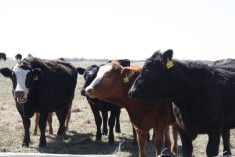This cattle market information is selected from the weekly report from Canfax, a division of the Canadian Cattle Association. More market information, analysis and statistics are available by becoming a Canfax subscriber by calling 403-275-5110 or at www.canfax.ca.
Fed market steady
Alberta fed steers and heifers last week traded at $242.56 per hundredweight and $239.74 per cwt., respectively, holding steady from the previous week and in line with seasonal trends.
Read Also

Defence investments could benefit agriculture
A bump in Canada’s NATO spending commitments could lead to infrastructure investments that would benefit rural areas
Dressed sales were reported at $405 per cwt delivered. There was moderate competition with two packers buying cattle. A light volume of western Canadian fed cattle were marketed into the United States. These cattle were sold on a formula and will be priced off the five-area average.
The October live cattle contract traded $1.90 per cwt. stronger than the previous week. The Alberta cash-to-futures basis reported at minus $9.61 per cwt., the weakest basis in 27 weeks and the fourth weakest for the same week in the past decades.
For the week ending Sept. 21, Canadian fed cattle and cow exports to the U.S. totalled 13,591 head, up 11 per cent from last year, with western Canadian fed and cow exports totalling more than 10,000 head for the second consecutive week.
Ontario fed prices held steady at $242.70 per cwt. Dressed sales were reported at $406 per cwt. The Ontario cash-to-futures basis was reported at minus $5.56 per cwt.
In the U.S., live sales in the southern feeding states were from US$185-$186 per cwt., steady to $2 per cwt. stronger than the previous week’s trade. Trade in the north was from $186-$188.50 per cwt. live, steady to $2.50 per cwt. stronger; and $294-$296 per cwt. dressed, $1-$2 per cwt. stronger.
Last week’s kill was estimated at 611,000 head, down 1,000 head from the previous week and was the seventh consecutive non-holiday week where slaughter volumes have been more than 600,000 head.
Lower cow prices
Cow prices were lower last week, but the western Canadian cow market is still the highest in North America. Alberta cow prices traded at a $18 per cwt. premium compared to Ontario and at a $15 per cwt. premium against the U.S. market.
Last week, D2s averaged $179.60, D3s averaged $167.44 and slaughter bulls averaged $200.53 per cwt.
For the week ending Sept. 28, western Canadian cow slaughter totalled slightly more than 5,100 head, 27 per cent below last year. For September, western Canadian cow slaughter volumes are the smallest since 2020.
Both major packers and feeder cow buyers have been active. There have been a few grain-fed cows on the market over the past few weeks and little to no premiums paid. The butcher bull market has seen a larger price pull back compared to the cow market. It is more export driven, and weaker prices in the U.S. took some of the shine off the Canadian bull market.
With the fall calf run getting underway, larger cow numbers are still ahead. Based off the five-year and 20-year averages, cow prices historically don’t bottom until late November-early December.
Feeder contracts rally
From their lows in late August-early September, feeder cattle contracts have rallied $13-$18 per cwt. while live cattle contracts have gained $10-$15 per cwt. The calf market has been faster to respond to the strengthening futures market, while heavier weight feeder prices have trended sideways.
Last week, there was a good mix of calves and yearlings on offer, with a few preconditioned calves that have been weaned for 45 or more days also available. With lighter volumes of pre-conditioned calves, no premiums were being paid compared to freshly weaned calves.
Eastern Canadian buying interest on the Alberta-Saskatchewan market seems to have moderated compared to a few weeks ago. As volumes seasonally increase, logistics issues could be one factor resulting in softer eastern Canadian feedlot demand.
Year over year, the largest price increase has been on Ontario heifer calves. On average, Ontario heifer calves from 300-600 pounds are $80 per cwt. higher than a year ago, whereas heifers of the same weight in Alberta are $9 per cwt. higher than a year ago.
For the week ending Sept. 21, Canadian feeder cattle exports to the U.S. totalled 2,375 head, 41 per cent below last year but in line with the five-year average.
Alberta calf prices are at a premium against the U.S. market, and import volumes may be large.
Over the past five years, the average decline from October to December for 900 lb. steers is around 3.5 per cent. This would put 900 lb. steers on track to bottom in the $305 per cwt. area.
Cutouts steady
In U.S. beef trade, Choice cutouts managed to climb a slight one per cent higher than the previous week to US$299.80 per cwt., while Select ended the week fully steady at $283.29 per cwt.














